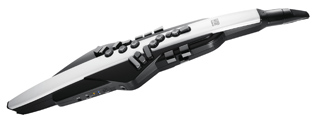Electronic Wind Instruments Sound History

|
|
|
|
|
|
|
|
|
|

Below is an English language version reformatted by Patchman Music of a wonderful article written by Ken Fujimoto about the history of wind controllers. This article was originally published in the Japanese language at DTM Station https://www.dtmstation.com/archives/71911.html
A very special thank you goes out to author Ken Fujimoto for generously allowing Patchman Music to translate and re-post his excellent article.
| Be sure to check out the amazing Aerophone Academy Podcast co-hosted by Patchman Music's own Matt Traum and Alistair Parnell (iSax Academy) for in depth discussions and interviews on everything related to wind controllers! |
A Complete Report on the "Sound History of Electronic Wind Instruments":
A Look at Half a Century of Evolution from Lyricon to YDS-150
by Ken Fujimoto
June 10, 2025
On February 28th 2025, the "Electronic Wind Instrument Talk & Live - Electronic Wind Instrument Sound History" was held at the Kakehashi Arts and Culture Promotion Foundation Hall in Waseda, Tokyo, and was a very valuable event that allowed us to trace the history of electronic wind instruments in one go. For me, Ken Fujimoto, who acted as the moderator, it was a rare opportunity to see so many vintage and current models of equipment in one place and to hear directly from the developers.
On the stage of the venue, electronic wind instruments that have continued to evolve for more than half a century, from the Lyricon born in 1971 to the latest YDS-150, were lined up in a row, and it was a spectacular sight like an electronic wind instrument museum. We were able to spend a luxurious time experiencing the trajectory of the evolution while playing the actual instruments. At the venue, saxophonist Takahiro Miyazaki, who is also known for being a member of T-SQUARE, wind synth player BANANAsu, who is a strong player who owns 30 electronic wind instruments at home, Roland Aerophone developer Yuji Terada, the company's demonstrator Yuri Nakamura, Yamaha YDS-150 developer Hiroshi Miyazaki and performer Kenta Fukui gathered. The development stories and technical details told from each expert's perspective were a must-see for wind synthesizer enthusiasts.
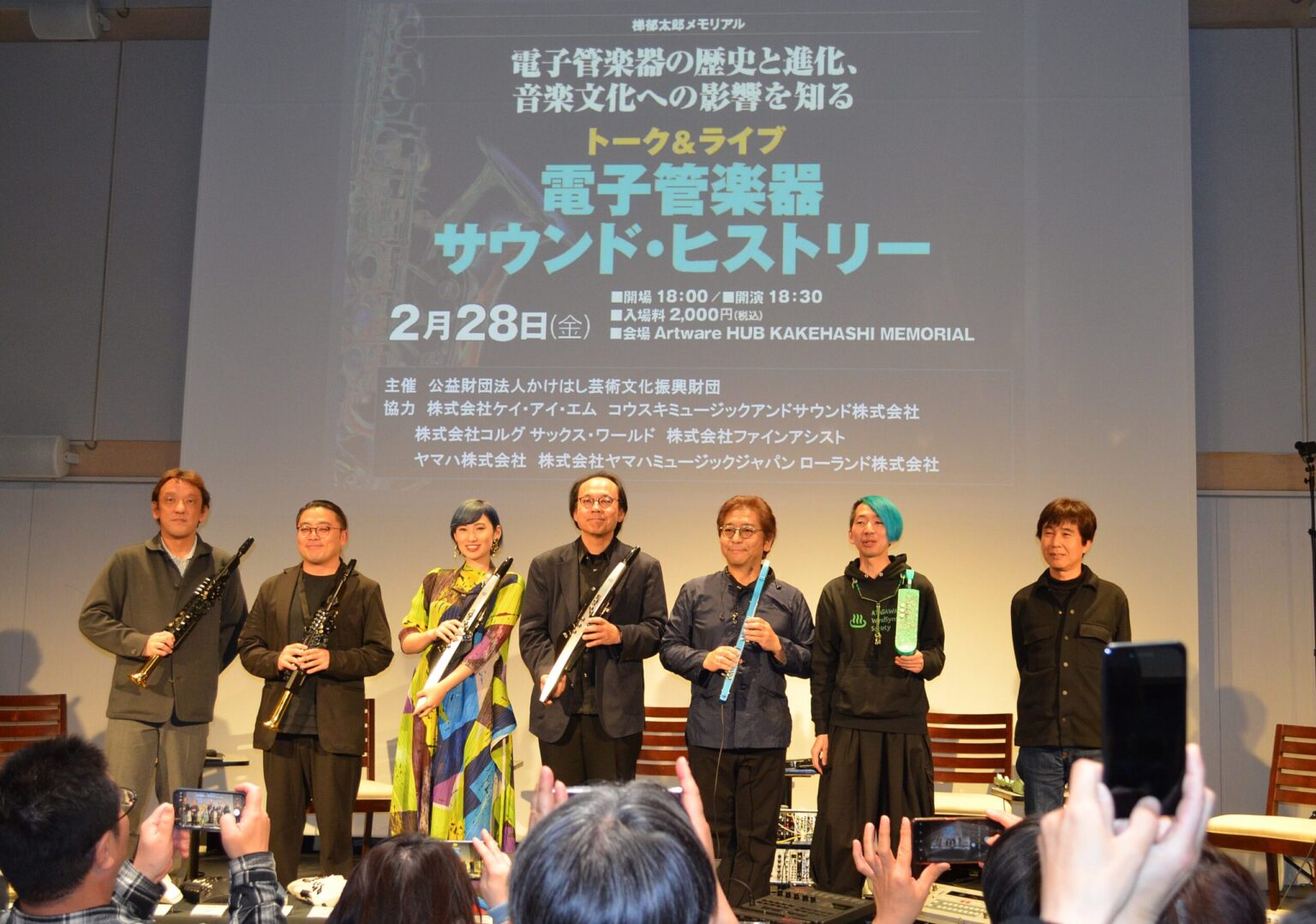
On February 28th 2025, a talk event called "Electronic Wind Instrument Sound History" was held
Table of Contents
- The origin of electronic wind instruments and the evolution of their names
- A history that began with the Lyricon in 1971
- Nyle Steiner and the Birth of EVI/EWI
- The Introduction of the Yamaha WX Series and the Era of FM Synthesis
- Casio's attempt to popularize the DH-100
- Roland Aerophone Innovation
- Yamaha's new strategy embodied in the YDS-150
- A new era for the electronic wind instrument market
|
An interesting point at the beginning of the event was the discussion about how to call electronic wind instruments. As the moderator, I asked a question about the various names for these instruments, such as "wind synthesizers," "digital wind instruments," and "electronic wind instruments." Takachika Miyazaki honestly stated his opinion, saying, "From our perspective, we don't feel there is any particular difference in what we're playing. I wonder if it's okay to call them all wind synthesizers."
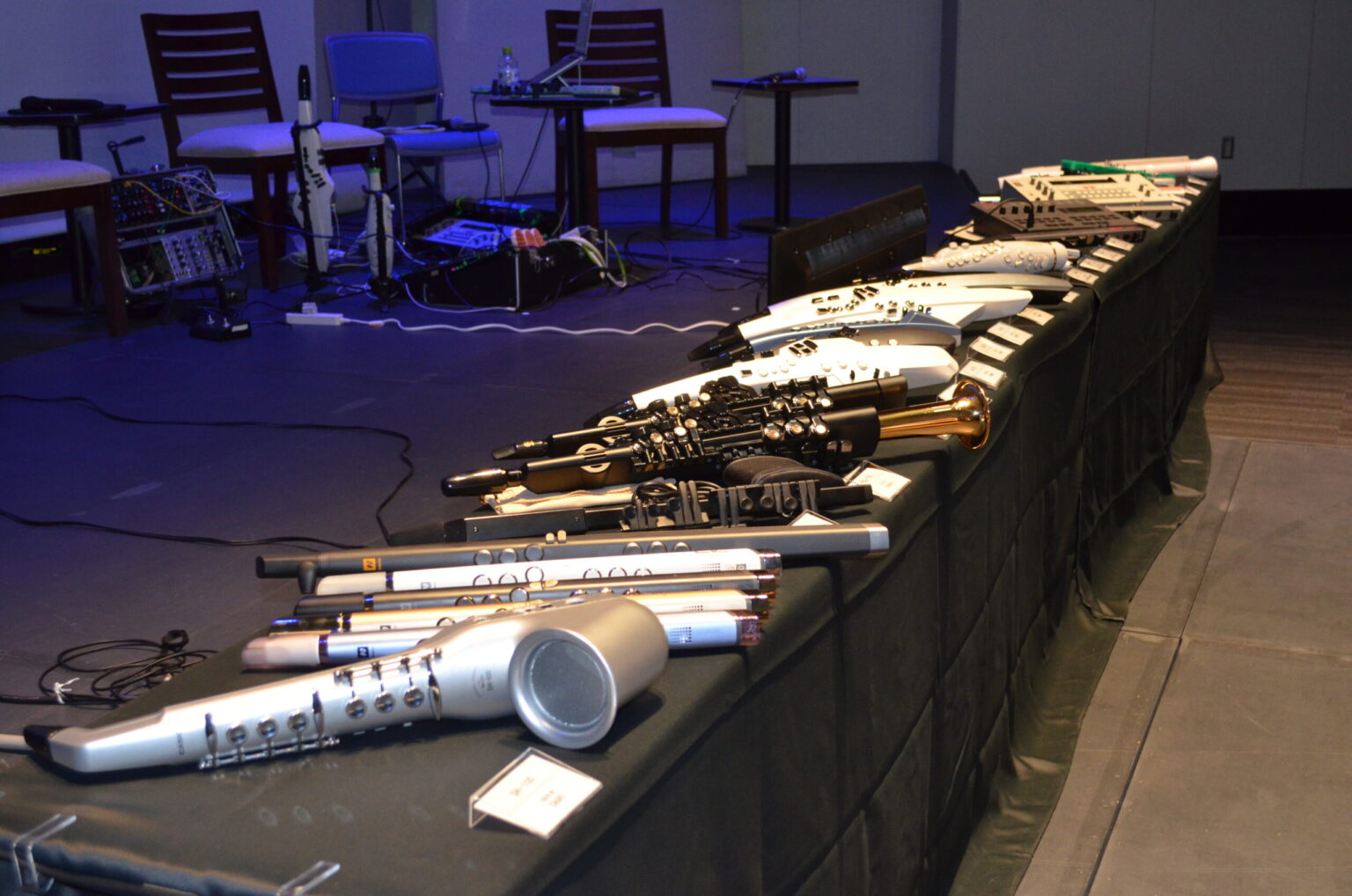
In front of the stage was a display of electronic wind instruments from various manufacturers released over the past 50 years
Meanwhile, BANANAsu made a very interesting point. "There are electric and acoustic guitars, and they are generally called guitars. That's what wind synths are, and I think there are various names for them depending on the manufacturer," he explained, using the analogy with guitars. He went on to analyze, "The terms digital wind instruments and electronic wind instruments are really new, aren't they? When you say wind synths, it sounds a bit difficult. They're all written in English, and some people think synthesizers have nothing to do with it. I think it's easier to understand if you group electronic wind instruments together."
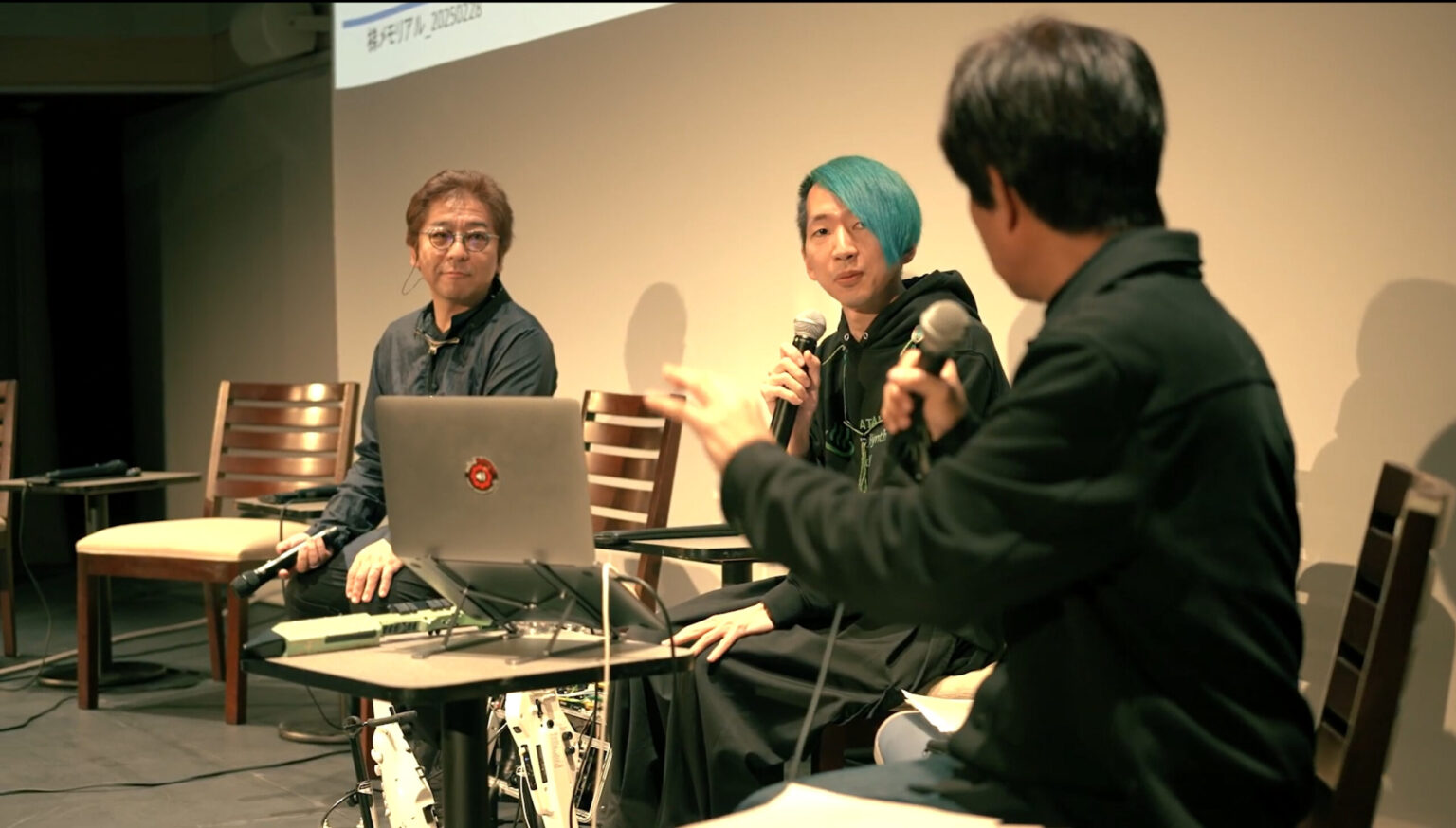
From the left: Takahiro Miyazaki, BANANAsu, and the author
It is true that for the general public, "electronic wind instrument" may be an easier term to understand. I feel that this change in name itself may indicate the expansion of the market and the widespread use of electronic instruments.
|
Tracing the history of electronic wind instruments, the oldest is the Lyricon, which appeared in 1971. An actual Lyricon2, personally owned by Takachika Miyazaki, was on display at the venue, and he even played it. It was impressive just to be able to see this precious instrument up close, but what surprised me even more was Miyazaki's comment: "When I first started playing the Lyricon, I thought it was so hard to control, but after I had it repaired, I was surprised to find that it was so easy to play." The Lyricon2 brought to the venue this time had been fully restored and was in beautiful condition, like new.

Takahiro Miyazaki performs on Lyricon2
There was an explanation about the unique name Lyricon. It was a coined word that comes from the fact that it is "a controller that you blow into as if you are singing lyrics," and it was an instrument that aimed to create singing-like expressions. Since Computone, the company that developed Lyricon, went bankrupt in 1981, it was a very valuable experience to be able to see this instrument in an actual working state.
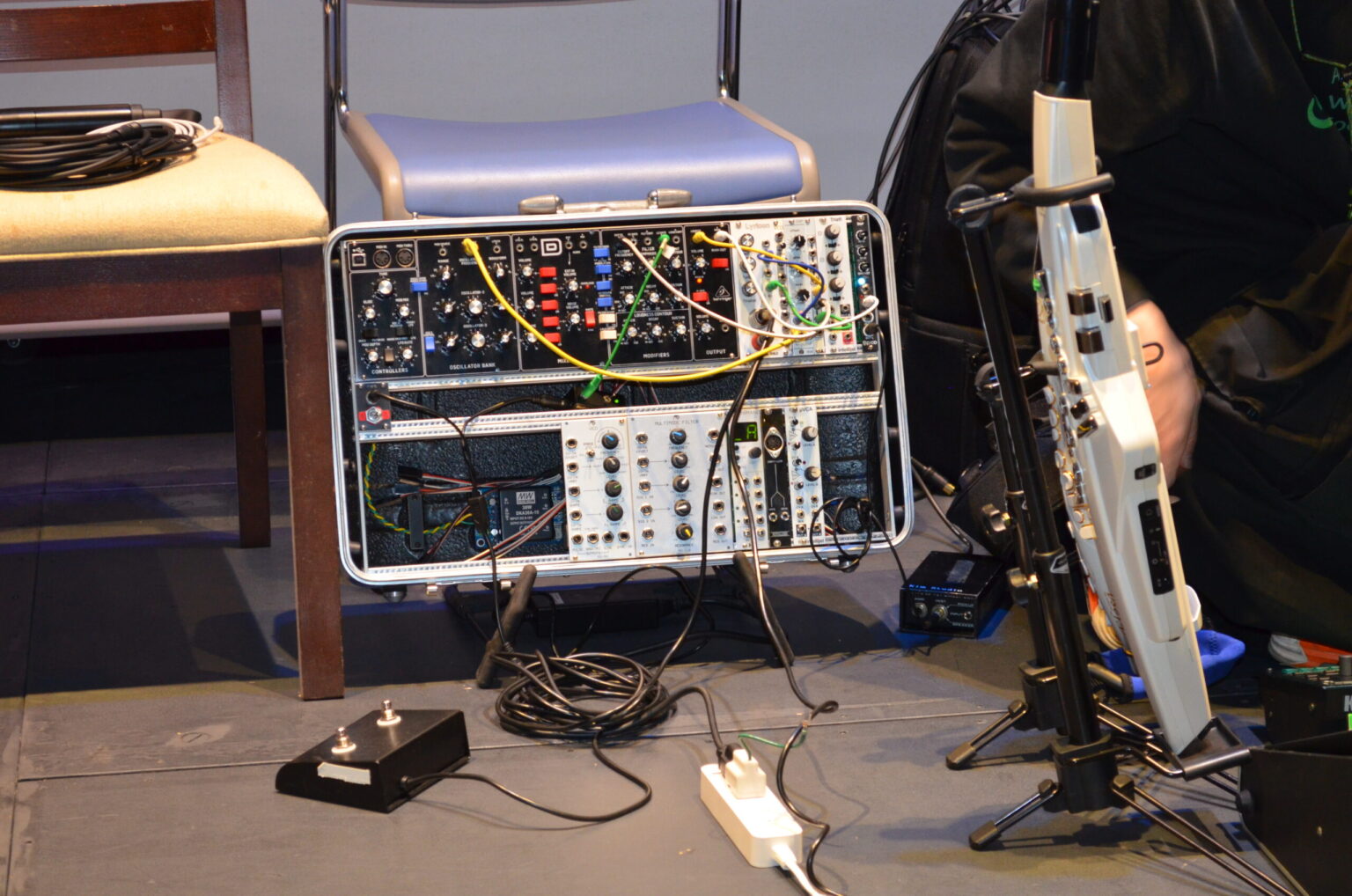
The sound source used when playing the Lyricon2 was a Behringer Model D (the black piece of equipment on the rack)
For Miyazaki's actual performance, he used a Behringer Model D (a reissue of the MiniMoog) as the sound source, and just as Miyazaki said, "It's just one oscillator. It has three oscillators, but I only use one, which is enough control," and we were able to hear a simple yet expressive performance.
|
Meanwhile, around 1979, Nyle Steiner, who was a trumpet player but also an electrical engineer, developed the EVI (Electric Valve Instrument). According to BANANAsu, "The first was a trumpet-shaped wind synth," and then "Nyle Steiner had originally been making various instruments by hand. For example, he made wooden wind instruments called Steiner Horns by hand, but he was told to make them by various places, and eventually he couldn't handle it by himself, so he approached Akai Electric at the time and decided to produce them under the Akai brand." He also introduced how Steiner later sold the rights to Akai, and the EWI1000 and EWV2000 were born. By the way, EWI is an abbreviation for Electric Wind Instrument.
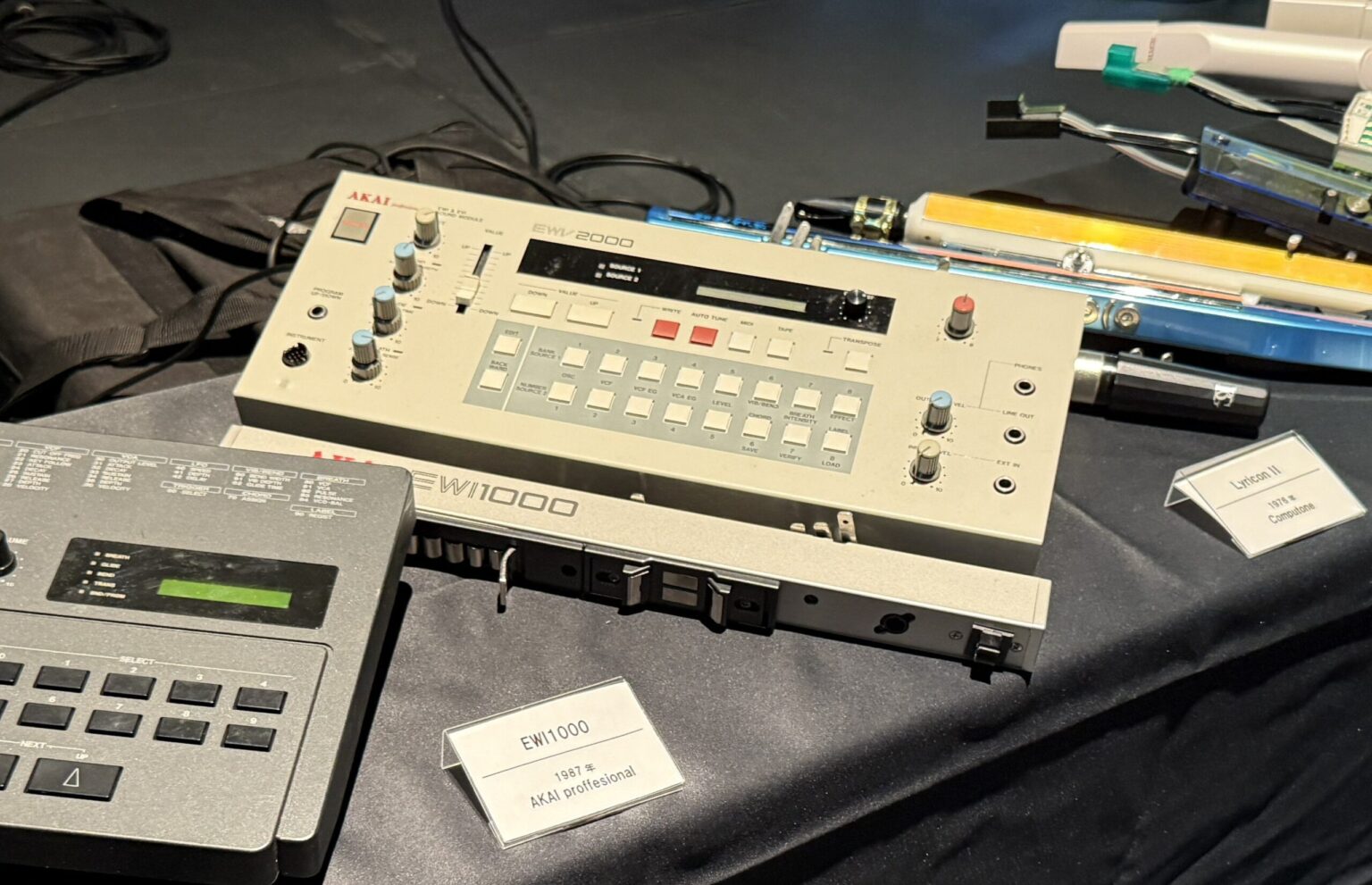
In the center is the Akai EWI1000, and above it is the sound source, the EWV2000
The EWV2000 brought to the venue played the "Judd" sound, which Takeshi Ito of T-Square still uses today, and the audience was amazed at the unique and powerful sound. As BANANAsu explained, "This is the sound that Takeshi Ito of T-Square still uses today, and it was included in the presets." A historic sound was also played.
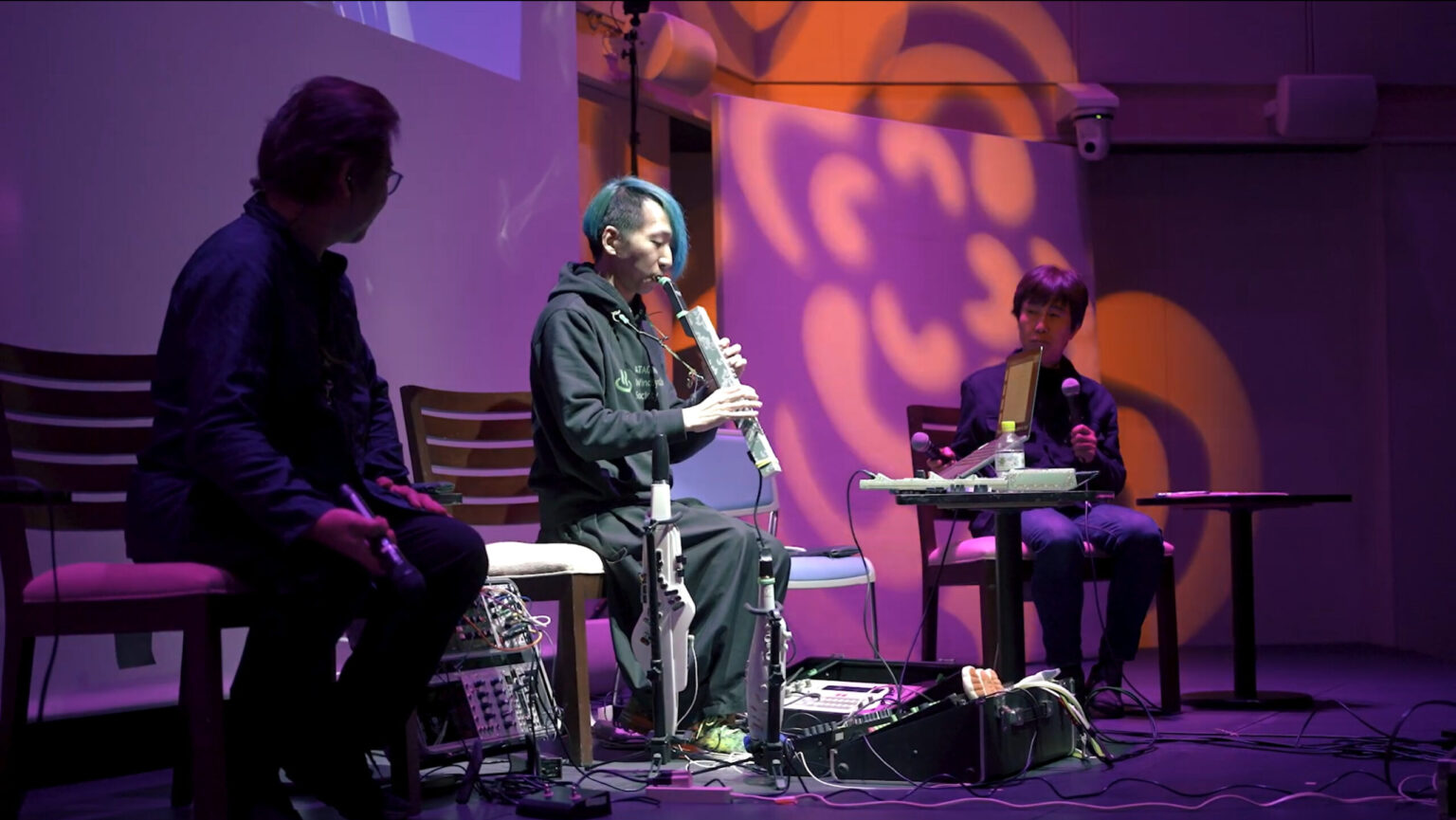
BANANAsu plays the EWI1000
What's interesting is that the EVI1000 is connected to a dedicated sound source via a dedicated cable. "It actually comes out of a signal called CV, so it has the feel of a pre-MIDI synth. It can only be used in this combination," says BANANAsu, making it truly analog synth world.
|
In the 1980s, Yamaha inherited the Lyricon patents and developed the WX7. The greatest feature of this instrument was that it was a revolutionary electronic wind instrument at the time, achieved by combining it with the FM synthesis that had made the DX7 so popular.

The WX7 released by Yamaha in 1987
BANANAsu performed on a green WX7, and although the electronic sounds were unique to FM synthesis, the refreshing sound had a unique charm. His comment after the performance was also impressive: "The departure sounds of the Yamanote Line are all made with FM synthesis, so they sound familiar. T-Square's Takarajima also used FM synthesis, so it's pretty much the same feeling."
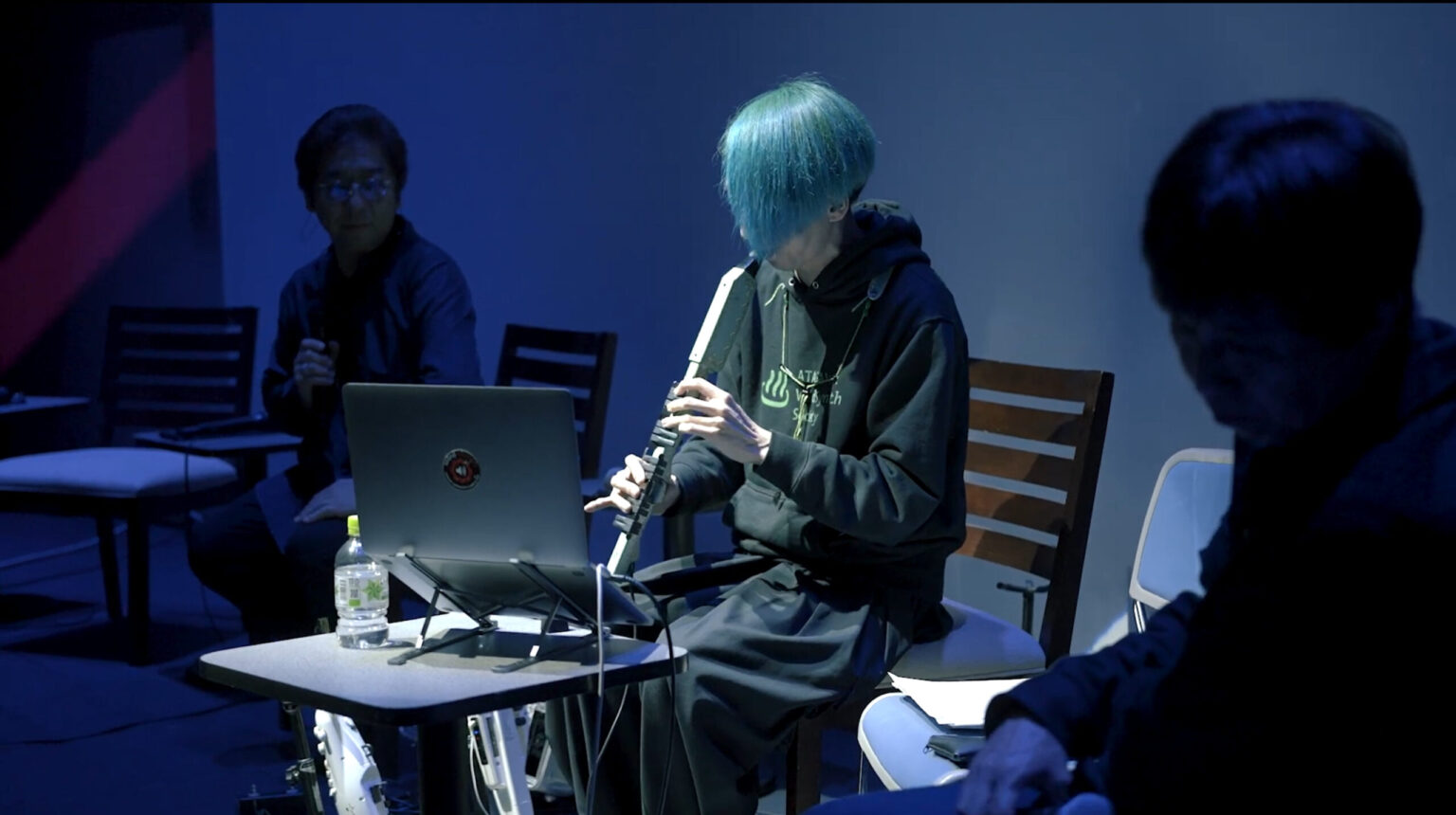
BANANAsu connects WX7 to opsix and plays
Indeed, the sounds of this era are representative of digital synths, with the DX7 sound used in many songs. BANANAsu said, "At home, I use a DX7 with a keyboard as a really big sound source, but it was a bit of a hassle to bring it over today, so I brought the opsix module, a KORG FM sound source that is also compatible with the DX7, and I'll try playing using that," and played the sound of the WX7 + FM sound source. By the way, he said that he connected the WX7 to the opsix module via a MIDI converter to play the sound.
|
In 1988, Casio released the DH-100 (digital horn). This device, which also featured a commercial featuring Akira Sakata, was a hot topic at the time due to its exceptional price of 33,000 yen. Takachika Miyazaki reflected, "It was very easy to use, and I think it was made with a completely different approach from what enthusiasts were looking for," and revealed that it also had a unique function, "which would automatically apply vibrato if you kept blowing for a certain amount of time."
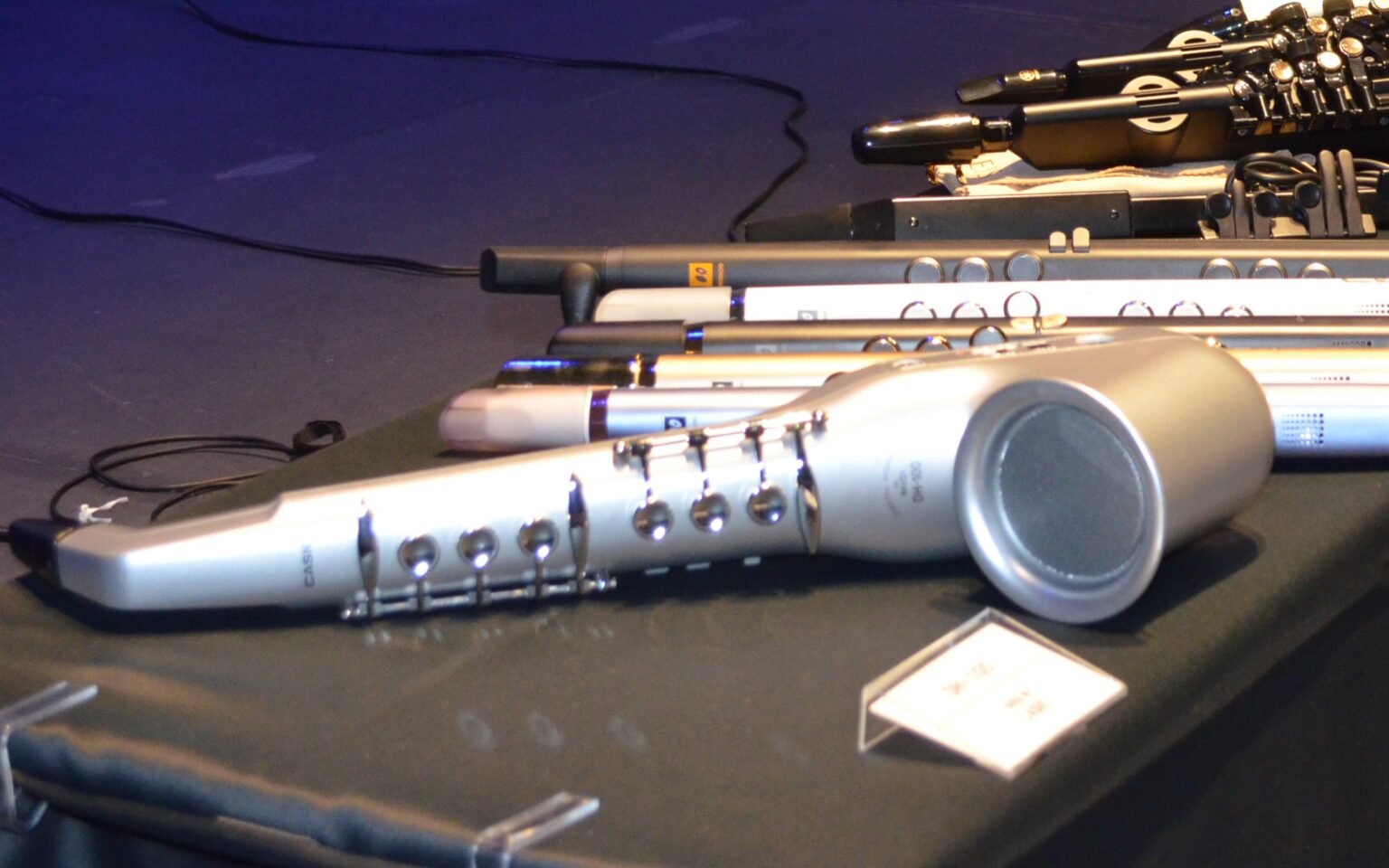
The DH-100 was released by Casio in 1988 for the bargain price of 33,000 yen
The DH-100 also had a MIDI OUT port, so it could be used to control external sound sources. Casio subsequently released the DH-200, a black model of the DH-100, and the DH-800, which was compatible with ROM packs. In June of the following year, 1989, they released the higher-end DH-500, which was equipped with a breath control function, and in November of the same year, they released the DH-280, but this marked the end of the DH series.
|
We had the opportunity to hear a detailed story from developer Yuji Terada about the Aerophone AE-10, which Roland released at great length in 2016. Roland is a long-established manufacturer of synthesizers, so when we asked why they hadn't entered the electronic wind instrument market until now, Terada answered frankly...
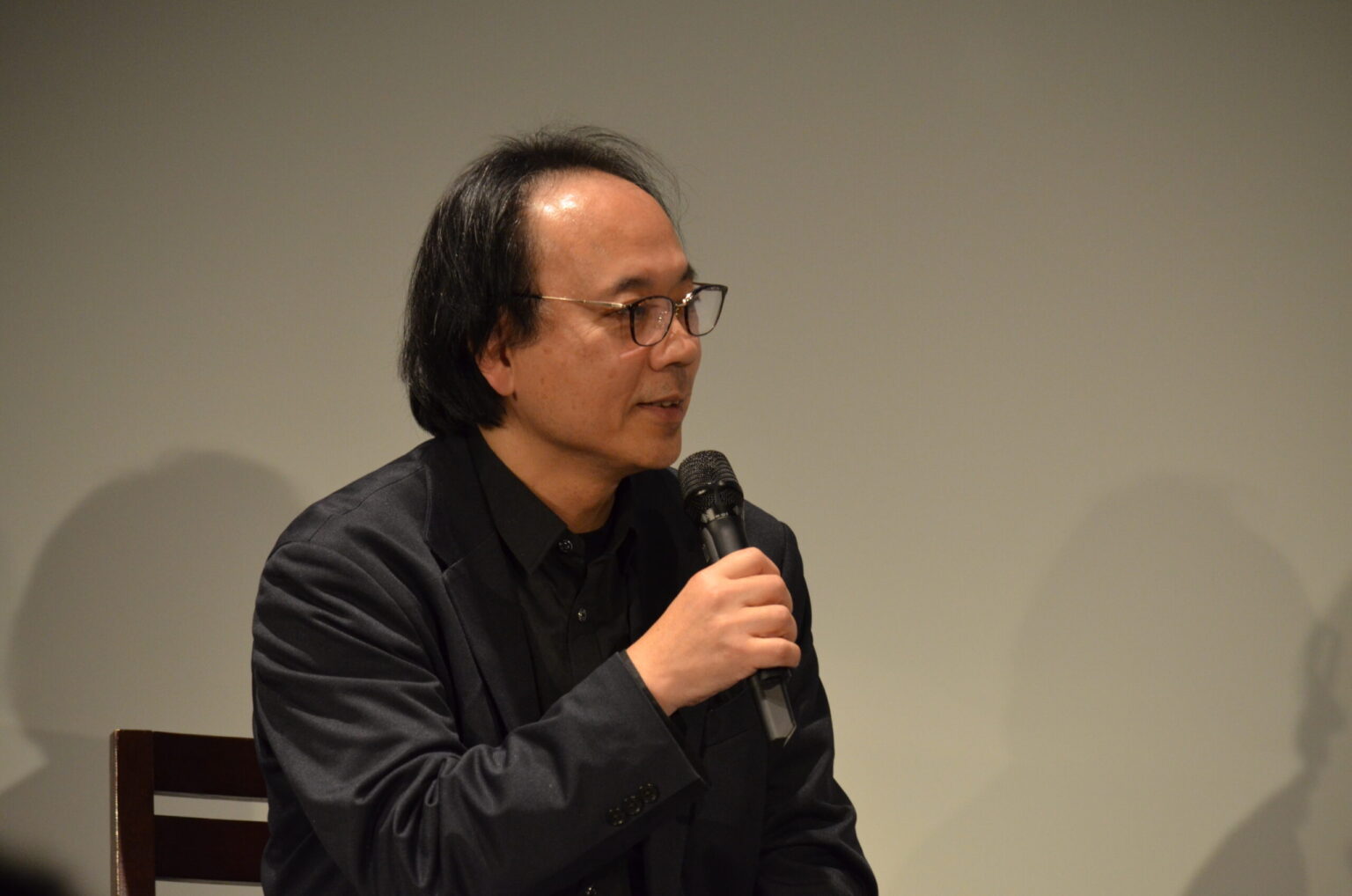
Yuji Terada of Roland, developer of the Aerophone AE-10
"We had been doing basic development for a long time, but it was difficult to bring it to market." So why did they enter the market at this time? The reason was the maturity of the technology. "The technology for the SuperNatural sound source had been established."
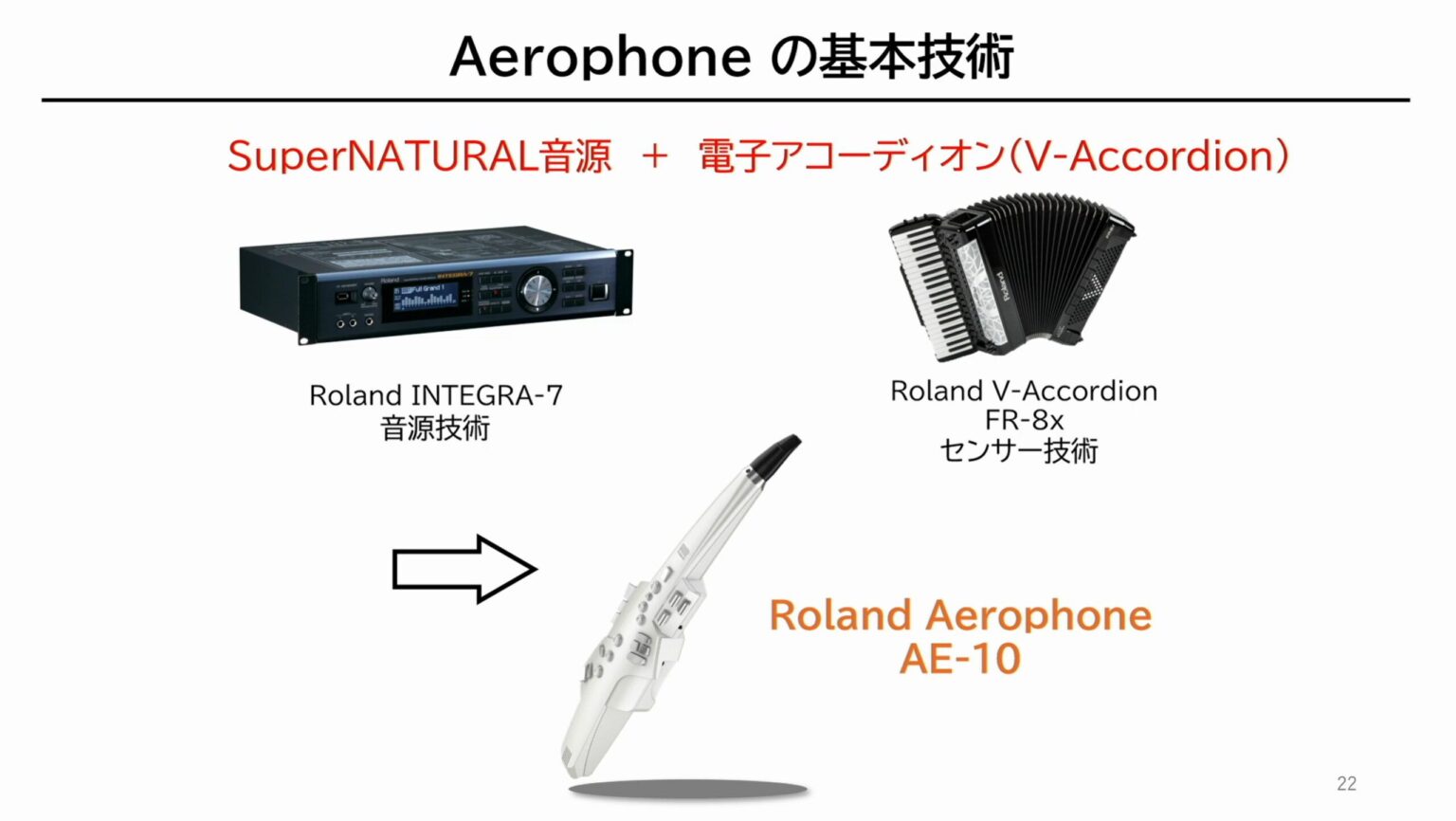
Aerophone is born from the combination of SuperNATURAL sound source and V-Accordion technology
"SuperNatural was able to reproduce the rich, expressive quality of acoustic tones, and at the same time, our company's electronic accordion, the V-Accordion, had a mechanism for producing sound using air, and by combining these technologies, the first Aerophone was created."
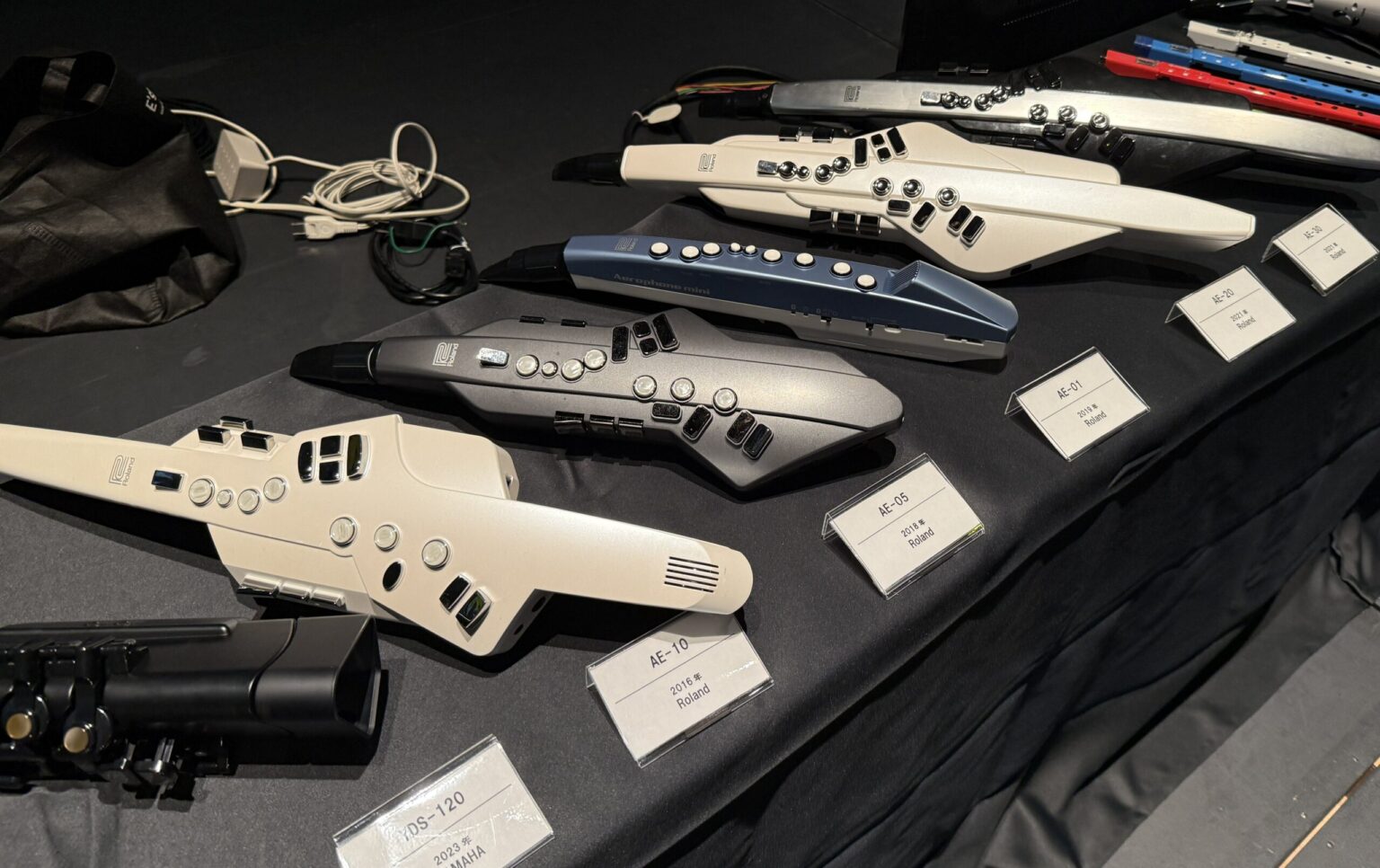
Roland Aerophone series
There was also an interesting anecdote about the design. When I asked about the shape, I was surprised to learn that "the designer's original motif was a dolphin." He explained, "As development progressed, we gradually moved away from the dolphin, but I think some traces of it remain in the original AE-10. We aimed for an organic design, like a musical instrument, rather than a mechanical one." His development philosophy was also interesting.
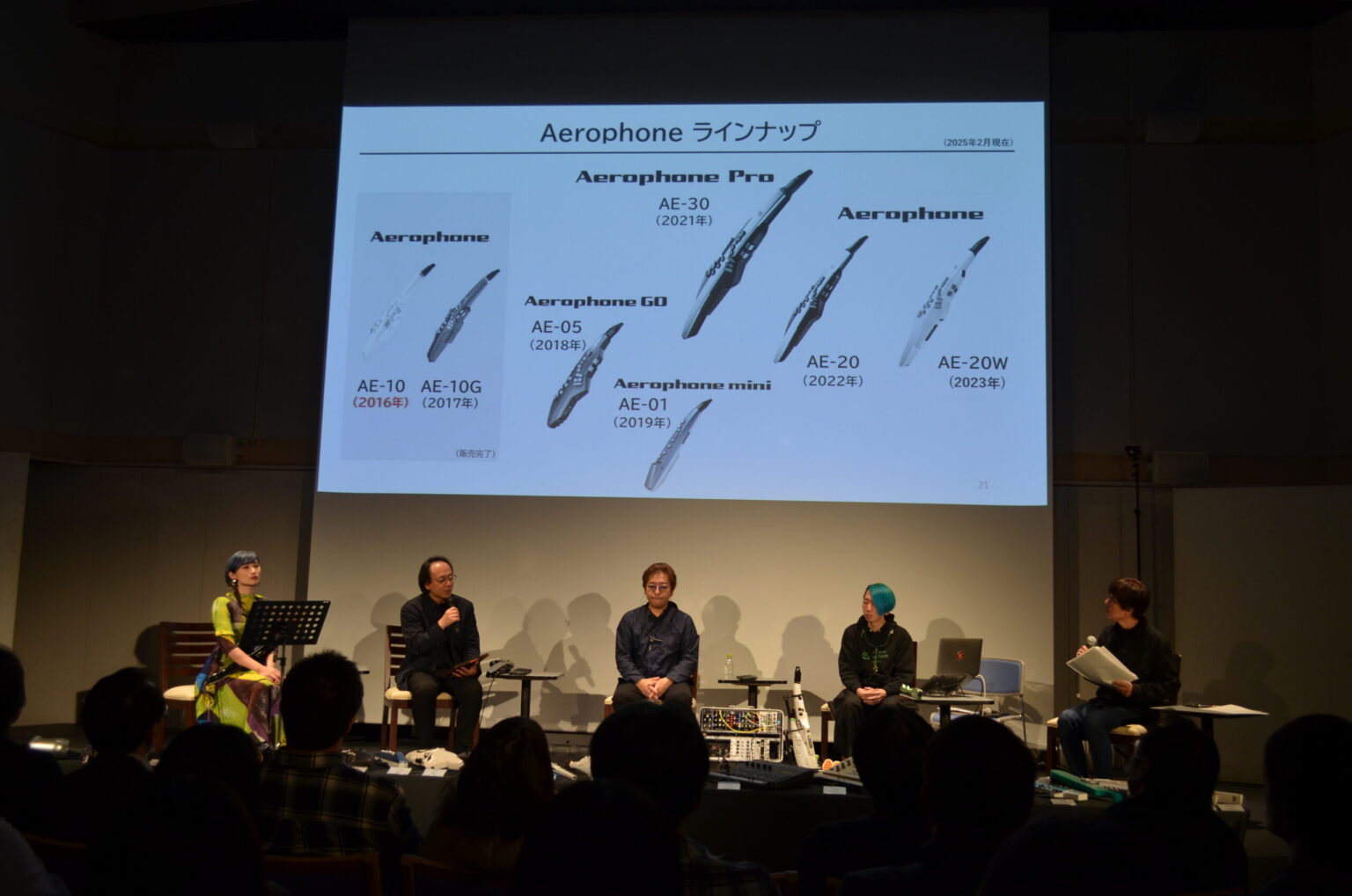
The Aerophone lineup was explained on stage as well
Even more impressive was the performance by Yuri Nakamura. She performed an Armenian dance using the Armenian folk instrument duduk, one of the 380 Aerophone tones that she particularly focuses on. The richness of her expression drew gasps of admiration from the audience.
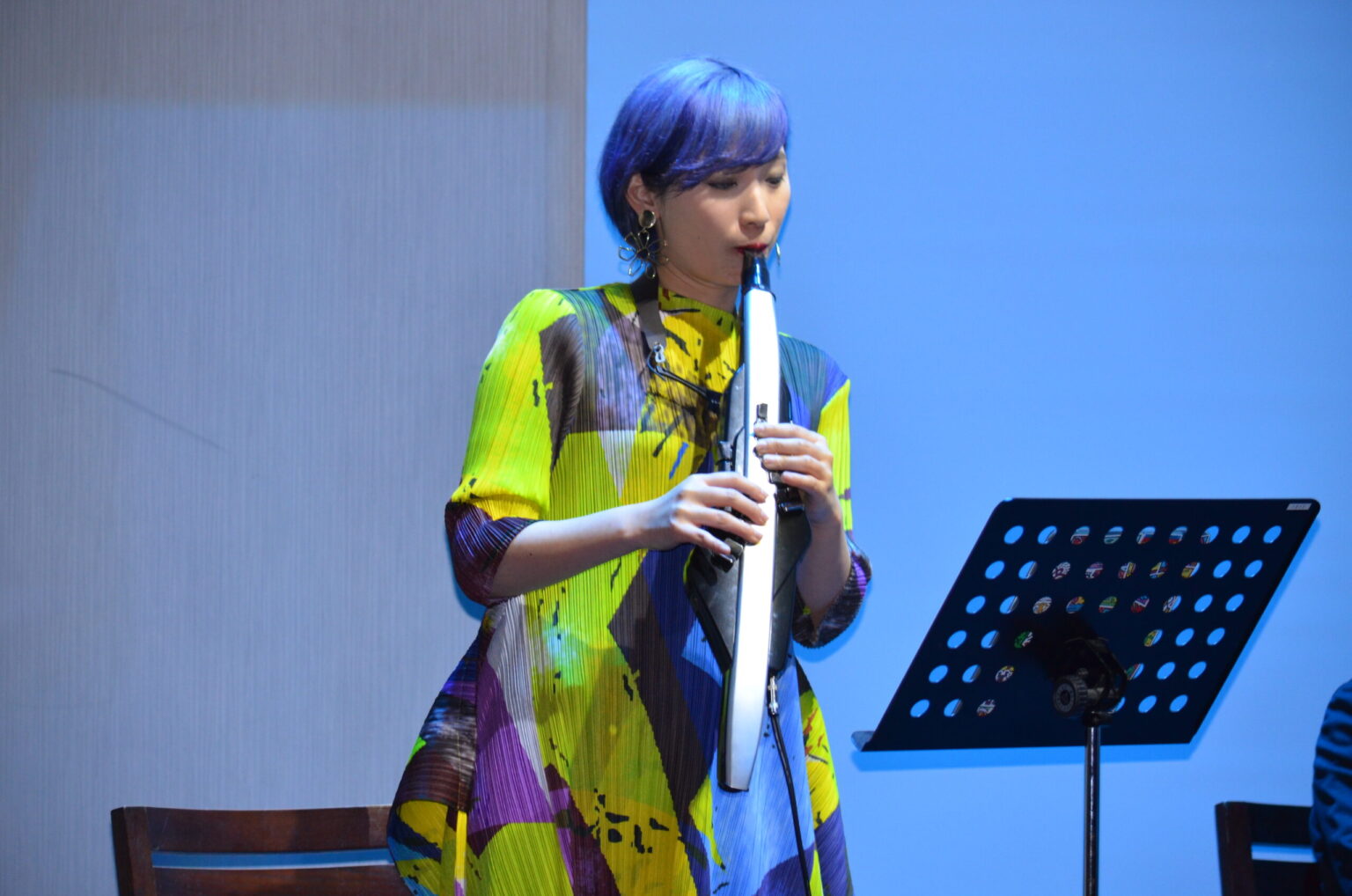
Yuri Nakamura also performed on stage using the AE-30
|
The last instrument to appear was the currently very popular Yamaha YDS-150. We had the opportunity to hear a very interesting story about the background of the development of this instrument from its developer, Hirofumi Miyazaki. The first thing that surprised me was that Miyazaki originally developed PA (professional audio) equipment.
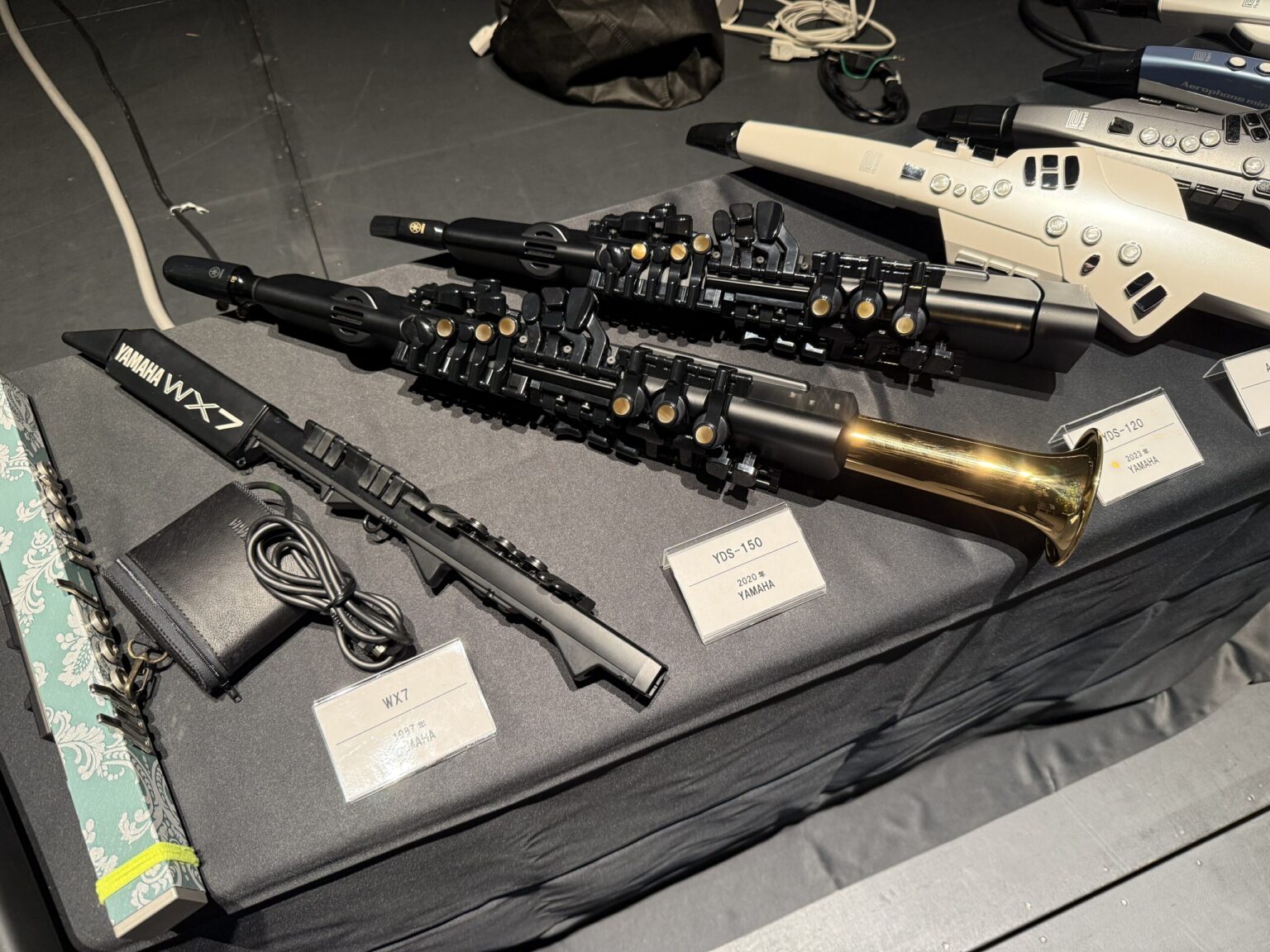
To the right of the WX7 is the YDS-150 which was released in 2020, and to the right of that is the YDS-120 which was released in 2023
"One day, I was tapped on the shoulder and told, 'Miyazaki, you're being transferred next week.'" This was the beginning of the development process. Miyazaki was the only one with a full-time position, while the other members had multiple positions. This made her feel a sense of crisis, thinking, "This is bad. I have to do something about this instrument. If this instrument flops, I might not have a place to go back to."
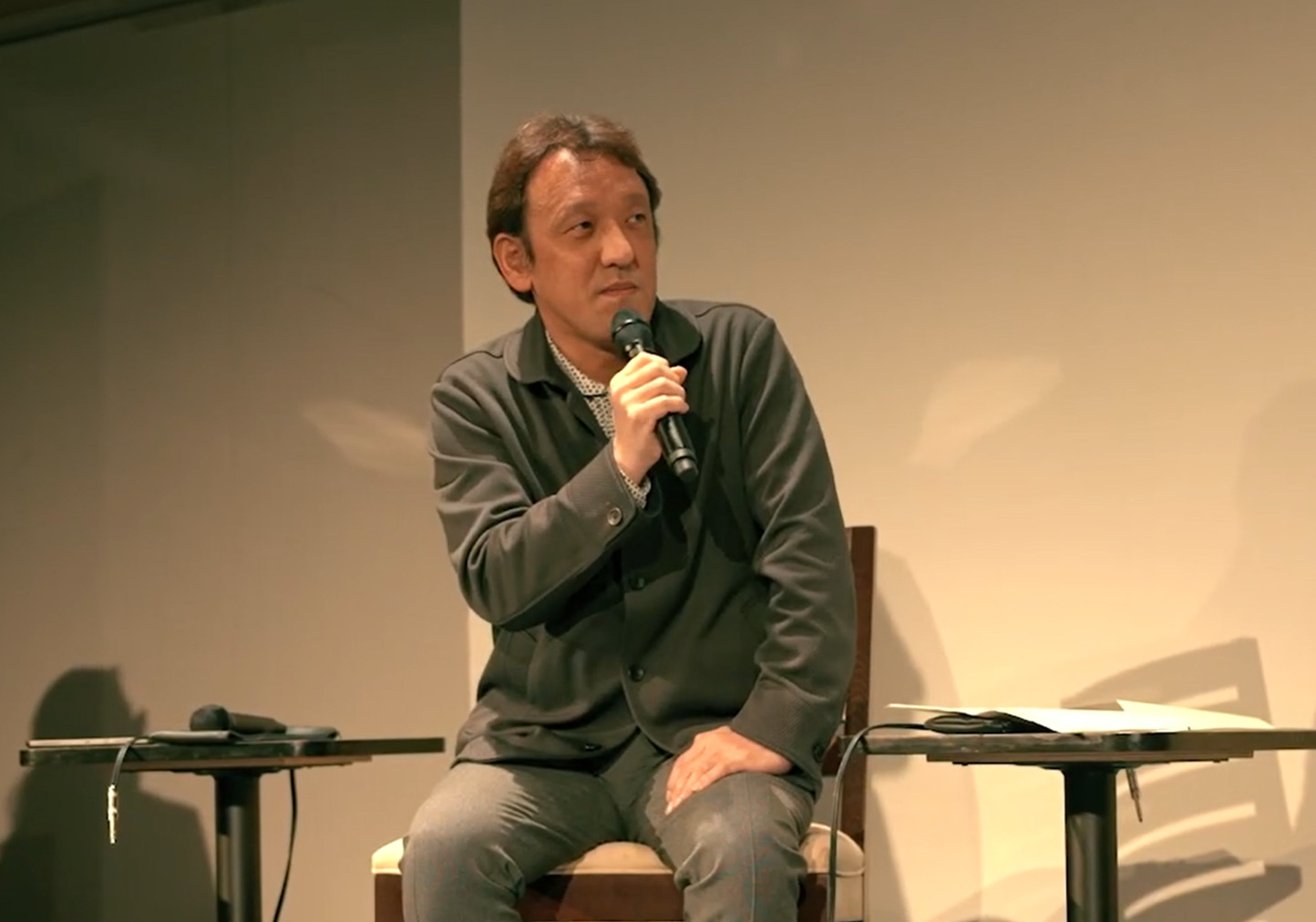
Mr. Hiroshi Miyazaki of Yamaha, developer of the YDS-150
The project was called the "WSD Project" (Windows Synth Development Project), but instead of making a wind synth, they decided to make a digital saxophone. There was a clear strategy behind this. "Since Roland was making the Aerophone, Yamaha didn't want to compete directly with Roland. Rather than fighting, we wanted to expand the market for electronic wind instruments and make them more popular," he said.
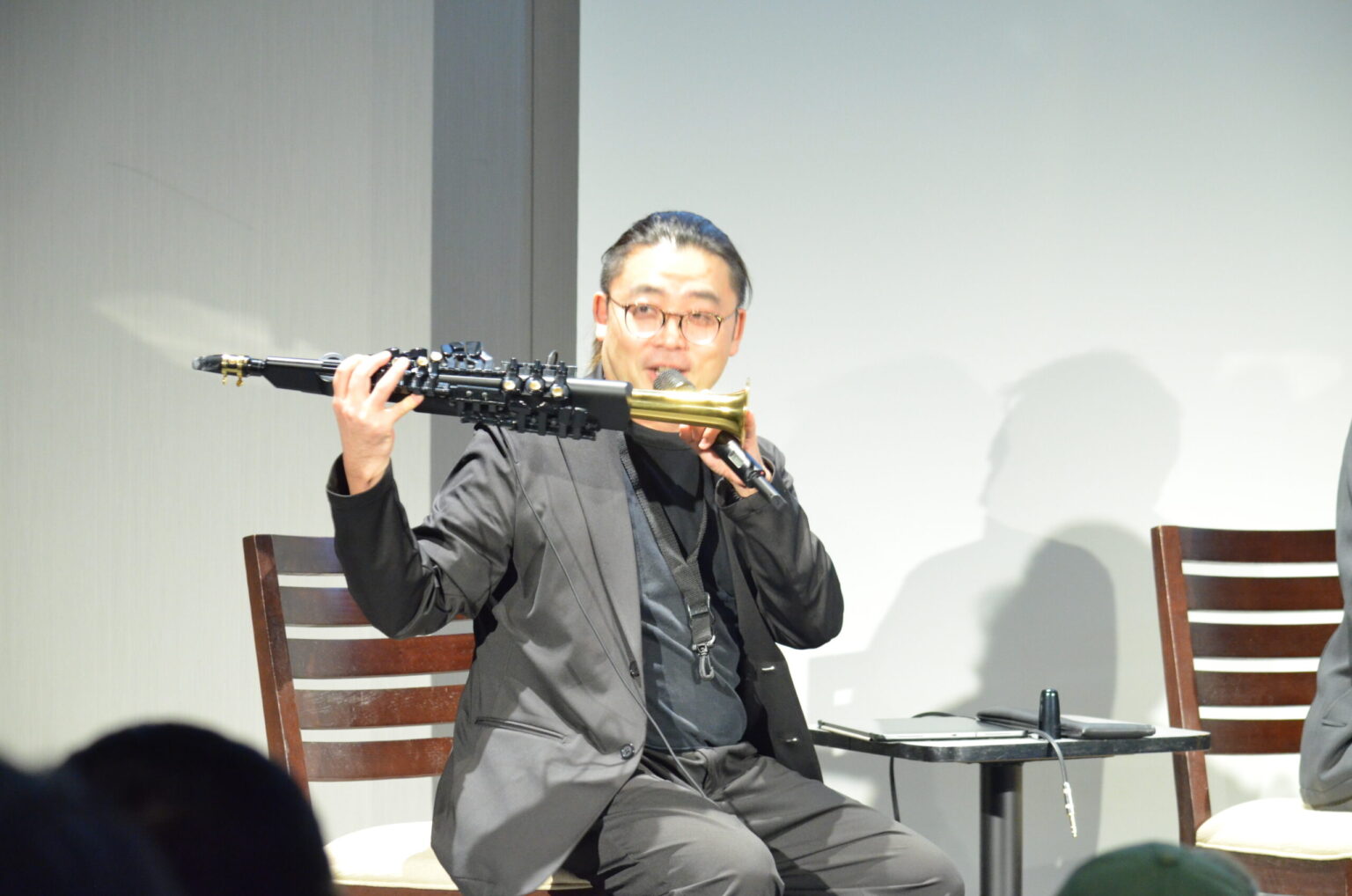
Kenta Fukui, a musician who was also involved in the development of the YDS-150
What was particularly interesting was the explanation of the positioning of the YDS-150. Miyazaki gave a specific example to explain that it is not a practice instrument but is focused on "the enjoyment of playing." "I often use the analogy that there are people who have a hobby of walking or gardening, but do you practice walking every day? Do you practice gardening every day? I don't think there are people like that. In the same way, the idea of having electronic wind instruments as a hobby" was something that set it apart from conventional electronic wind instruments.

Kenta Fukui also performed on the YDS-150
We also had the opportunity to hear more about his involvement in the actual development from Kenta Fukui. He revealed some behind-the-scenes details about the development, including the test play experience, which was conducted under strict confidentiality, saying, "Before this instrument was ready, I was told by Yamaha's headquarters, 'Don't post on social media that you're here today,' and they stamped their seal before I entered the room," and the specific advice he gave, "Yamaha is, after all, a manufacturer of saxophones, so if you make the key layout the same as a ready-made saxophone, I think we'll be able to play it without any hesitation."
|
At the venue, various new electronic wind instruments were also exhibited, including the latest NuEVI, Elefue, and Lunatica. What was particularly noteworthy was the diversification of prices, with a wide range of options available, from high-end models that cost over 100,000 yen to entry-level models that can be purchased for around 10,000 yen. First, in the high-price range, there is NuEVI, developed by Swedish company Berglund Instruments. According to Takahiro Miyazaki, "genealogically, it is an evolution of EWI," and there is an interesting connection between the NuEVI and Akai, in that "the president before Akai was acquired by inMusic is now the distributor in Japan." "In terms of usability, it's exactly the same construction, so anyone who can play it will definitely be able to play it. However, it doesn't have a built-in sound source, so you need to use some external sound source," he said, making it the most expensive product currently available.
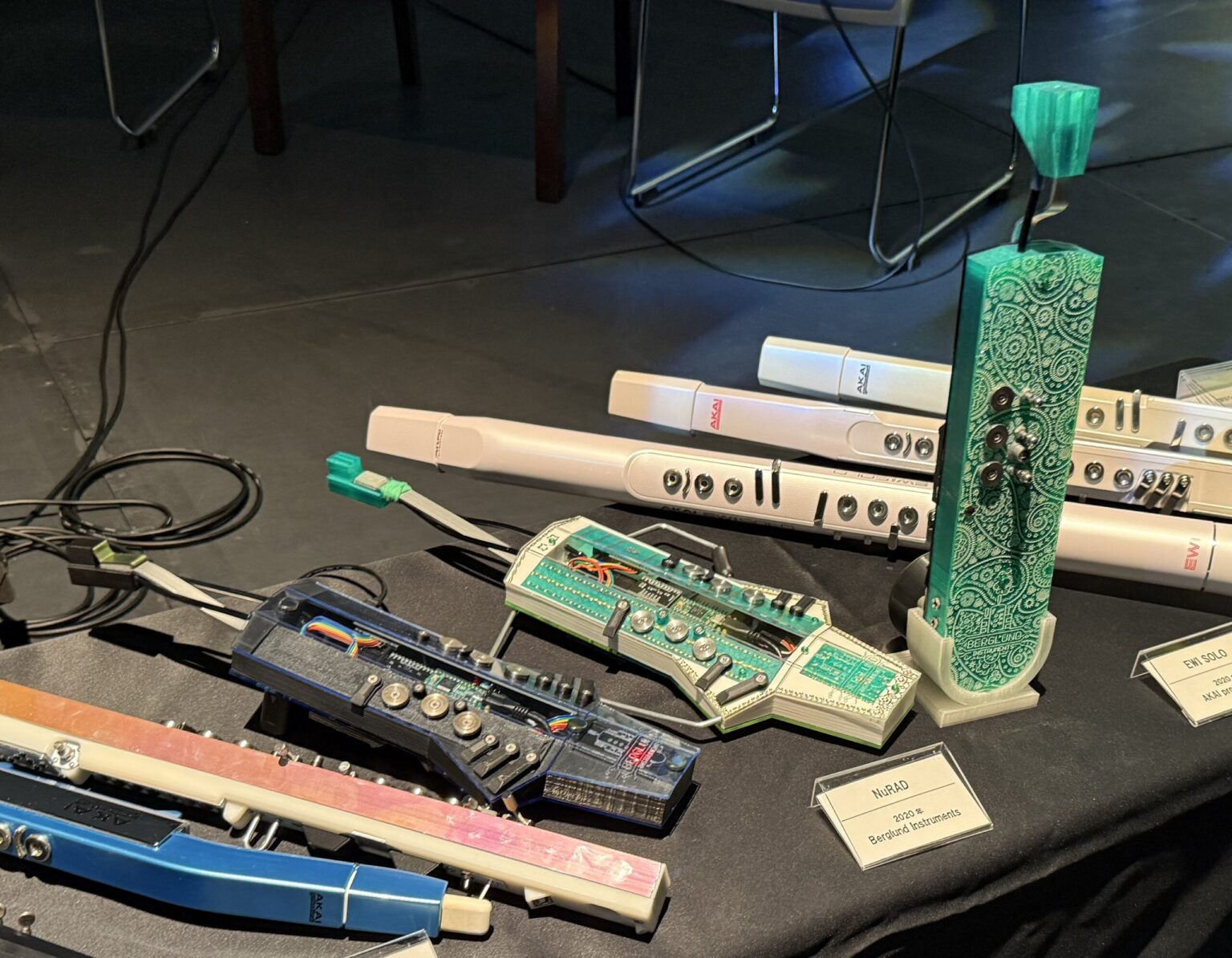
The gray and green model lying flat is the NuRAD from Berglund Instruments, and the green model standing up is the NuEVI
Meanwhile, revolutionary products have appeared in the low price range. The Elefue, from a manufacturer called TAHORNG, is "an electronic version of a recorder, so it's the same size as a recorder," and "you can choose the fingering type as with a recorder. It's lightweight, has 10 tones, an earphone jack, and can use Bluetooth." Despite its high functionality, it was priced at an astonishingly low 14,000 yen at the time. According to BANANAsu, it is "the cheapest wind synth on the market."

From left: Lunatica, Elesa10, Elsesa-W1, Elefue
Recently, TAHORNG has released the Elesa 10, which is shaped like a saxophone, and the newer Elesa-W1. Meanwhile, the Italian company ARTNoise has released the Lunatica, which is sold domestically by KORG. The interesting thing about Lunatica is that it's actually a live recorder. It can be used as a recorder, and when you put on the mute cap, it can be used as a Bluetooth controller.
The venue also introduced a product called MWiC, which was developed by Professor Takashi Tokuda of the Tokyo Institute of Technology (now Tokyo University of Science). According to Takachika Miyazaki, it is "a wind synth that the professor is making alone as a hobby," but "it's interesting because there are so many things it can do," giving the impression that it is an ambitious work by a developer with an academic background.
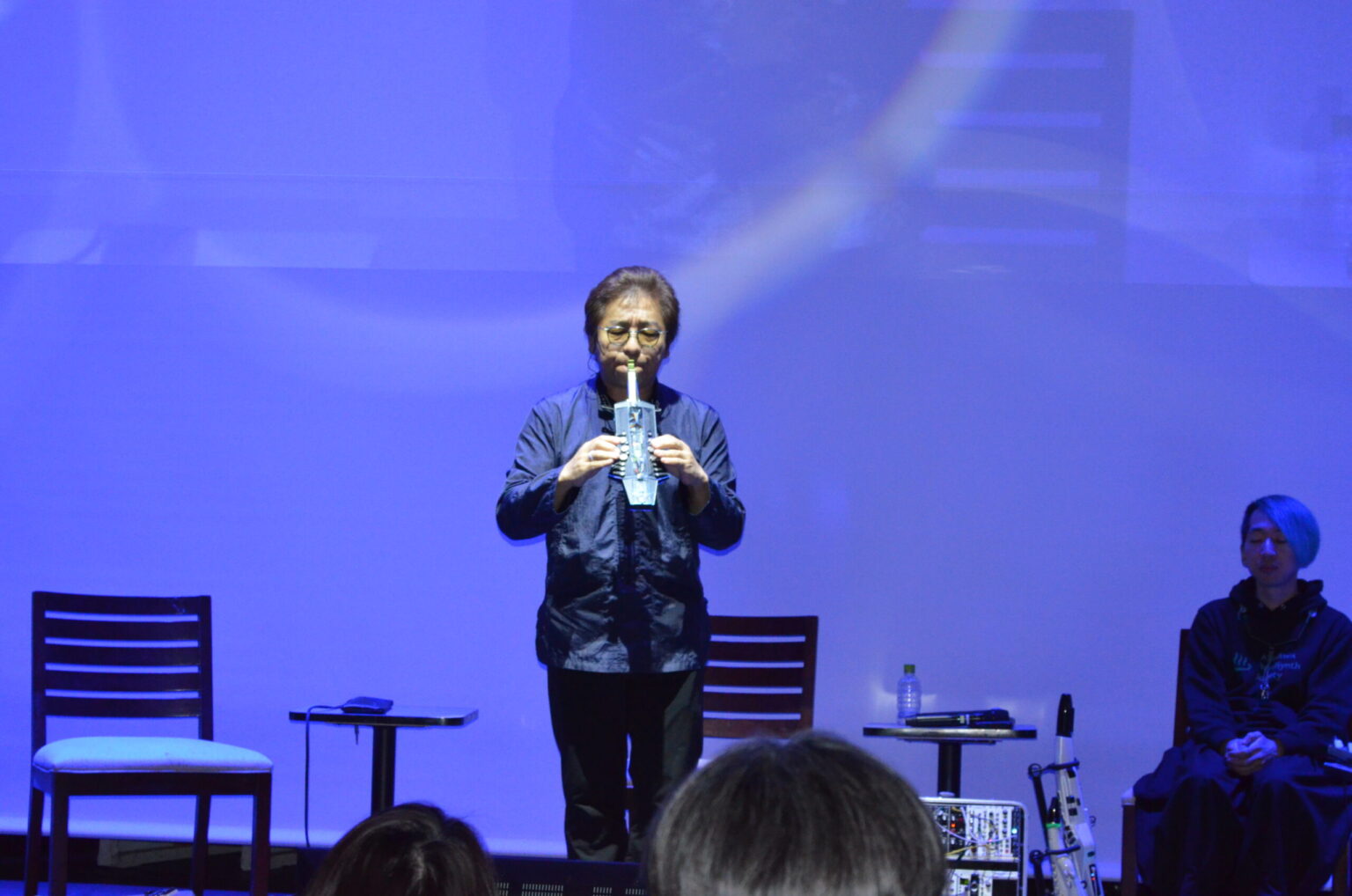
The Electronic Instrument Sound History ended with a performance of NuRAD by Takahiro Miyazaki
Looking at these new products, it is clear that the electronic wind instrument market has been revitalized. Takahiro Miyazaki also felt the change in the market, saying, "The wind synth boom in the past few years has been amazing. It's easy to get inexpensive products, and that has given other manufacturers a new lease on life." BANANAsu also made an interesting observation, saying, "I guess a while ago, no one really touched them or was interested in them, but as we've been doing more and more, I feel like there are fewer people who say, 'I've seen that on a streaming service,' or 'I'm seeing it for the first time.' "Indeed, with the spread of streaming and social media, it may be that awareness of electronic wind instruments, which were previously a niche market, is increasing."
|
You can see this history of electronic musical instrument sound on YouTube below, where you can also hear the actual sounds being played, so be sure to check it out...
|
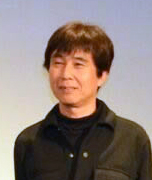 Ken Fujimoto
Ken Fujimoto
A writer who writes mainly about DTM, digital recording, and digital audio.
He has been serializing Digital Audio Laboratory in Impress's AV Watch since 2001.
He has also written many books, including "Cubase Complete Operation Guide" (Rittor Music) and "Vocaloid Technology Theory" (Yamaha Music Media).
You can visit Ken Fujimoto at https://www.dtmstation.com/
His hobby is solar power generation, and since 2004 he has been using solar power for his home electricity, and is currently the manager of three power plants.
|
For more information on Electronic Wind Controllers, visit The Wind Controller FAQ
For more information on Nyle Steiner and the history of the EWI and EVI, visit the Nyle Steiner Homepage
Buy your Wind Controller from Patchman Music The Wind Controller Specialists!! Click here to buy from Patchman Music We personally set up and calibrate EVERY wind controller we sell! |
The Wind Controller FAQ | Wind Controller Soundbanks
| Be sure to check out the amazing Aerophone Academy Podcast co-hosted by Patchman Music's own Matt Traum and Alistair Parnell (iSax Academy) for in depth discussions and interviews on everything related to wind controllers! |


Check out the INCREDIBLE PATCHMAN TURBO VL Upgrade Chip for the Yamaha VL70-m |

This page was last updated Wednesday, August 6, 2025
Copyright ©1996-2025 PATCHMAN MUSIC, LLC, All Rights Reserved
Purchase Terms and Conditions
All trademarks are property of their respective holders

